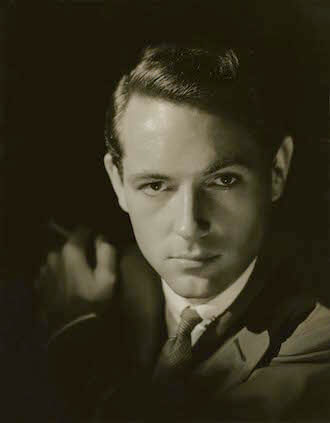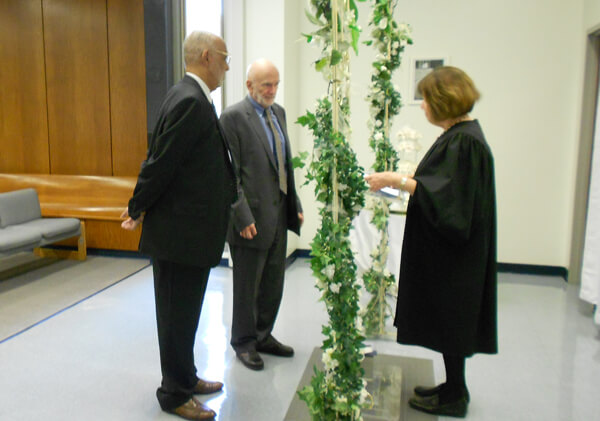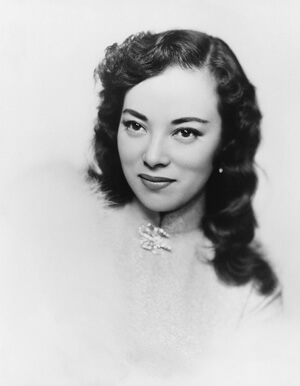For all you lovers of movie musicals, imagine “Meet Me in St. Louis” without the ebullient “ Trolley Song” number, or “Summer Stock,” without Judy Garland’s iconic “Get Happy” celebration. What about “Easter Parade” without the raffishly amusing “We’re a Couple of Swells,” “Gigi” without the effervescent “The Night They Invented Champagne,” or no Garland campily swanning as a high diva of cinema in “Ziegfeld Follies of 1946?” None of these indelible moments would have been possible without one man, Charles Walters, who often received no onscreen credit for his contributions.
The allure of the great musicals of MGM’s golden era remains ever-potent, and the creators of these classics — directors Vincente Minnelli, Stanley Donen, and Gene Kelly, and producer Arthur Freed — are always celebrated. But Walters remains an elusive, largely forgotten figure. Born in Pasadena in 1911, he was first a successful Broadway hoofer, with bigger aspirations, who returned to California to become an integral part of the revolution in musicals that was happening at MGM in the 1940s, eventually directing triumphs like “Good News,” “Easter Parade,” “Lili,” “Billy Rose’s Jumbo,” and “The Unsinkable Molly Brown.”
Writer Brent Phillips was struck when he recognized the lack of basic information about this hugely talented man, and he has righted things with his book “Charles Walters: The Director Who Made Hollywood Dance.” Exhaustively researched as so many movie books are, it is still a true rarity among them — beautifully written, with a canny mixture of knowing affection and clever analysis, which effortlessly sweeps you back in time to the most heady days of Culver City.
Without Charles Walters, there would have been no great MGM musicals
“This was a total labor of love and a joy to research,” Phillips told me. “I knew that if I didn’t write it, it might not ever get written, and what a loss not to have this career in some way encapsulated so that people would know who he was and what he did.”
Obsessed with MGM musicals from the age of 12, he recalled, “My mother had a reissued ‘Easter Parade’ soundtrack album which merely described Walters as a dancer turned director. I kept seeing mentions of his name on something random like ‘Please Don’t Eat the Daisies,’ or the choreography for ‘Meet Me in St. Louis,’ so I wanted to somehow put all of this together and really show his career arc. He went from being a very successful Broadway performer to becoming a choreographer and dance director, and finally an Academy Award-nominated director.
“Eight years ago, when I began this, I was surprised that I couldn’t find more about him. He died in 1982 before anybody could write his story, an only child with a longtime relationship with a much younger man whom he adopted, and then he died. So basically Chuck Walters’ story disappeared, and he was not good about promoting himself for many reasons. He loved the work more than anything, and didn’t need the fame, although the money was important.”
Charles Walters with Judy Garland and Gene Kelly, circa 1949. |COURTESY OF THE JOHN FRICKE COLLECTION
A book like this is always a race against time, Phillips explained: “June Allyson, the star of ‘Good News,’ died within the week I decided to really research this, and I thought, ‘Oh boy!’ I tried several times to interview Esther Williams, but she’d had a stroke or some problem with her health. She did send one message through a friend: ‘Just let him know that Charles Walters was my all-time favorite director.’ Leslie Caron could not have been more gracious, and Debbie Reynolds was wonderful, tactful, and everything you could imagine her to be. And then, to find behind-the-scenes people, I often had to rely on archival interviews, because I figured if, say, Tony Martin talked about him10 years ago, that’s good because he would have remembered things. So it was important to gather all these stories.
“I do have a day job [film archivist for NYU’s library], and this meant lots of trips to Los Angeles in my spare time. At USC, librarian Ned Comstock is the gold standard, every writer’s dream. As a fellow archivist, he makes us all look bad, steering me to Walters’ papers and also those of his producers — Arthur Freed, Joe Pasternak, and music arranger Roger Edens. He would even come across something in, say, Variety, and would photocopy and send it to me. He’s unparalleled in the world of archiving.”
I asked Phillips if he had an a-ha! or “Rosebud” moment of discovery about Walters’ life and he said, “I don’t think he had one enemy, lasting so long at MGM from 1942 to 1964, just hard-working and talented, and I was surprised by how much money he brought into the studio, one of the most fiscally profitable directors of them all. The fact that he’s not better remembered is odd. I was also struck by how much he did not get credit for — like working for two weeks cleaning up ‘Gigi,’ which won an Oscar for Vincente Minnelli — the ultimate company man with no ego.”
The fully integrated musical as we know it today was being pioneered on both coasts in the early ‘40s, by Rogers & Hammerstein on Broadway and by Walters, working with the famous Freed unit at MGM.
“As a choreographer on ‘Meet Me in St. Louis,’ it was all about continuity, bringing the story along and developing the characters and their relationships, and it all had to be done intelligently by someone like him — how to segue into a number, how it was going to be constructed so people remain in character, and how to dovetail out of it and back into the storyline.
“When Walters got an assignment, the first thing he asked for was the script, and at first they said ‘What do you need you that for, you’re the choreographer?’ He wanted to know what had happened in the scene before, and where the story was going to create the number. Another dance director would have made a very different movie than ‘Meet Me in St. Louis,’ as we know it, and, of course, he was in conversation with Minnelli on everything.”
Charles Walters, circa 1938. | COURTESY OF BRENT PHILLIPS
My favorite Walters anecdote struck me like a thunderbolt when I read it in a published interview when I was about 12; Phillips said he had the same reaction at around the same age. In Walters’ account, during the underrated Judy Garland vehicle “Summer Stock,” after she sang the song, “Friendly Star,” “Judy looked up with those giant liquid eyes of hers, and it was the most fantastic shot in the world. ‘Cut,’ I yelled, ‘will someone hand me a towel, I’ve just cum!’ Now that might be thought indelicate, but Judy loved that sort of foolishness. ‘C’mon what’s next?,’ she’d ask.”
That silly yet telling little tale revealed so much to my young, formative mind, as my nascent gaydar blaringly went off. How very gay that remark somehow seemed to me, and how comfortable he must have been with both his star and in the confines of a big, homophobic corporation like MGM to be able to make that remark in front of his entire crew. Phillips added, “Yes, and the fact he did that because he knew Judy would love it. She was that type of performer — big stars are still thrilled by that kind of gay chorus boy humor — and the same kind of jokes are made now.
“As a gay man, it’s important not to forget Walters’ heritage. Everybody wasn’t just a hairdresser or scenic designer. Although now forgotten, Chuck was a top-tier director, like the quarterback everybody had to be behind, and the fact that he had such respect in an industry that was so homophobic and knew how far he could go and continue to work is impressive.
“I think his staying out of the spotlight had something to do with this. It was the 1950s, in the midst of McCarthyism, and a tabloid magazine like Confidential could end your career if you didn’t know how to stay off the radar. Thankfully, one of his partners, Jimie Morrissey, is still alive, and he told me that although you needed to show up at a Hollywood opening with a girl like, say, Chuck’s regular date, Debbie Reynolds, he also brought along his boyfriend, Jimie, who knew all the photographers. Chuck was also dating agent John Darrow, and there they would be with Louis B. Mayer, Freed, and all the upper studio echelon. No one talks about it, but Chuck didn’t kowtow to anyone saying, ‘You can’t do that.’ He stayed out of the spotlight and lived his life as openly as one could then, and he was so beloved, talented, and making so much money they allowed him to flourish.
“I was surprised doing research when I saw the census in New York for 1940 and it had John Darrow as head of household, with Charles Walters listed as partner, not ‘roommate,’ or any other euphemism. Where else does the word ‘partner’ come up, not roommate or any other euphemism. He and Judy were even rumored to be engaged to be married in a possible MGM arrangement, but Chuck said, ‘No, I’ve worked too long and hard to get here and I don’t want to be Mr. Judy Garland. Shortly thereafter, she married Vincente Minnelli. Chuck didn’t hide who he was.”
Phillips’ favorite Walters film is probably “Lili,” a little film which even the studio didn’t believe in, that went on to become an international smash and win six Oscar nominations, including Walters’ only nod for Best Director: “It’s a very special film, and being an ex-dancer, I gravitate toward it because its story is told through dance. But I am always amazed whenever a Walters film comes on TV. Before I know it, it’s three-quarters through, it just goes flying by.”
One of my favorite Walters movies is also a somewhat guilty pleasure: Joan Crawford’s big MGM comeback film of 1953, “Torch Song.” In some ways, it’s her “All About Eve,” in that she plays a temperamental star who wreaks havoc with everyone around her. Walters took on this almost B-level film with a weak script and a decidedly unmusical star playing a Broadway musical goddess as a special favor to both the studio and to Crawford, a personal friend, and invested it with juicy details culled from her actual life. There are the multi-layered curtains she uses to black out the light in her bedroom, which Crawford really had in her home, as well as a party she throws in which the only invited guests are men, to avoid any female competition.
Walters appears in the film as a chorus boy who trips over Crawford’s extended leg during a rehearsal, and when she’s asked to move it, she has the immortal camp riposte, “What, and spoil that line?” (Carol Burnett hilariously reprised this moment in her side-splitting TV takeoff, “Torchy Song.”) During the filming of this sequence, another great line came from a Crawford pal and former co-star, the flamboyantly gay William Haines, who was on the set and observed, “Only God or a good-looking man could get your legs up that high.”
Crawford developed a deep, misguided crush on her handsome director, plying him with lavish gifts and inviting him to her home for drinks. On one such occasion, she was fully glammed up but wearing a housecoat, which she opened to reveal her naked 48-year-old body.
Phillips said, “Chuck’s personal shooting scripts are at USC, and he would decorate them with candid photos with funny annotations which show his gay wit. The ‘Torch Song’ one is a work of art, with shots of everyone talking in mid-sentence, but Joan always knew where the photographer was and would be posing perfectly, and the caption would read ‘Another off-the-cuff moment with Joan Crawford.’ The very last photograph at the very back of the script sums up the whole ‘Torch Song’ experience. It’s of her poodle, Cliquot, resting his head on an electrical outlet, like a pillow, that reads, ‘Property of MGM.’”
Although Walters was a complete workaholic, having to deal with immense studio pressures, Phillips believes he was a happy man. “His films show this; they’re all optimistic. He may have had bitter memories about certain people, but overall he was a happy person. He loved going to Palm Springs, where gay men were able to let their hair down, and gay and straight, stars and non-stars, all played together. [Gossip columnist] Hedda Hopper was notorious during the witch hunts of the 1950s, but she liked Walters and was a guest at his Malibu beach house. I am thankful for her writing so much about him in her column, and she was one of his biggest supporters.
“Another big journalist, Mike Connelly, was gay, I’m almost positive, and he mentioned being at a Joe Pasternak dinner where Chuck got up and did an imitation of Judy singing ‘Zing Went the Strings of My Heart’ — phenomenal, because she had just started doing it in her live act in 1958 and Chuck had to have given her the choreography. It was kind of a dishy thing that Connelly wrote that, but I’m glad he did.”
CHARLES WALTERS: THE DIRECTOR WHO MADE HOLLYWOOD DANCE | By Brent Phillips | University Press of Kentucky | $40 | 368 pages






































